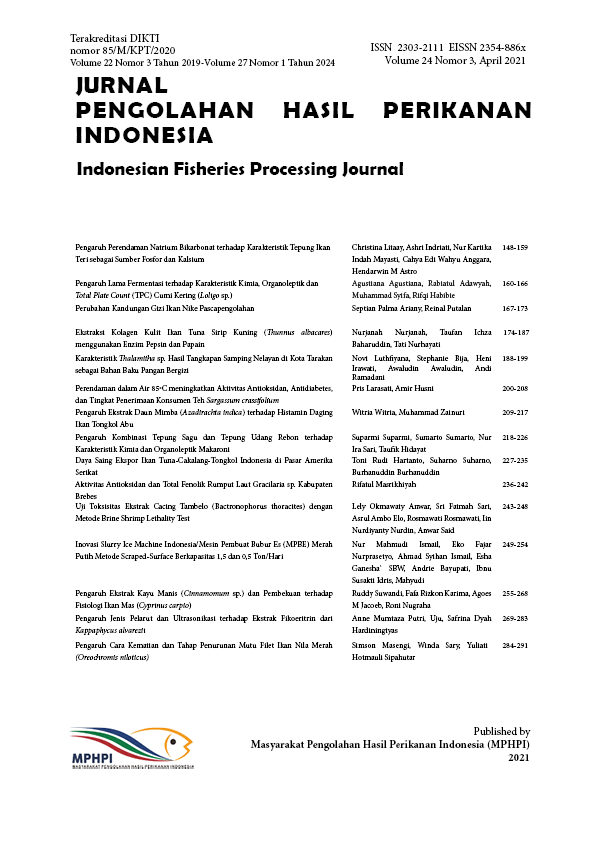Analisis In Silico Senyawa Aktif Sprirulina platensis sebagai Inhibitor Tirosinase Fatty Acid Profiles of Tuna Loin (Thunnus albacares) Sprayed by Filtered Smoke during Frozen Storage
Abstract
Hyperpigmentation is a condition when melanin is overproduced, causing spots on the skin. This condition apart from causing aesthetic problems, can also increase the production of reactive oxygen species at the skin. One way to deal with hyperpigmentation is through inhibiting the key enzyme for melanin synthesis which is tyrosinase. Spirulina platensis is a microalgae that has been widely used as a supplement and medicine because of its high nutritional content. S. platensis extract has been proven in vitro to have the ability inhibit ing the tyrosinase enzyme. This study aimed to find active compounds in S. platensis that have the potential as tyrosinase enzyme inhibitors. The active compounds found in S. platensis were explored through literature studies and then selected based on affinity, toxicity, and Lipinski's Rule. Molecular docking analysis was carried out with selected compounds against the tyrosinase enzyme with kojic acid as the control ligand. The results of molecular docking showed that kaempferol has the best potential as tyrosinase inhibitor since t has the most negative ΔG thus has the best affinity with the tyrosinase enzyme.
References
Balle T, Liljefors T. 2017. Molecular Recognition. Di dalam: Strømgaard K, Larsen PK, Madsen U, editor. 2017. Textbook of Drug Design and Discovery 5th Edition. Boca Raton (US): CRC Press
Costa JAV, Moro GMB, Filgueira DMVB, Corsini E, Bertolin TE. 2017. The Potential of Spirulina and Its Bioactive Metabolites as Ingested Agents for Skin Care. Industrial Biotechnology. 13(5): 244–252
Costa LG. 2013. Toxic Effects of Pesticides. Di dalam: Klaassen C, editor. 2013. Casarett & Doull's Toxicology: The Basic Science of Poisons 7th Edition. Pennsylvania (US): McGraw-Hill Professional.
Deri B, Kanteev M, Goldfeder M, Lecina D, Guallar V, Adir N, Fishman A. 2016. The unravelling of the complex pattern of tyrosinase inhibition. Scientific Reports. 6(1): 1-10
Di L, Kerns EH. 2015. Drug-Like Properties: Concepts, Structure Design and Methods from ADME to Toxicity Optimization. Cambridge (US): Academic Press
Eaton DL, Gilbert SG. 2013. Principles of Toxicology. Di dalam: Klaassen C, editor. 2013. Casarett & Doull's Toxicology: The Basic Science of Poisons 7th Edition. Pennsylvania (US): McGraw-Hill Professional
Ghose AK, Viswanadhan VN, Wendoloski JJ. 1999. A knowledge-based approach in designing combinatorial or medicinal chemistry libraries for drug discovery. 1. A qualitative and quantitative characterization of known drug databases. Journal of Combinatorial Chemistry. 1(1), 55–68
Khan S, Nazir M, Raiz N, Saleem M, Zengin G, Fazal G, Saleem H, Mukhta M, Tousif MI, Tareen RB et al. 2019. Phytochemical profiling, in vitro biological properties and in silico studies on Caragana ambigua stocks (Fabaceae): A comprehensive approach. Industrial Crops and Products. 131: 117–124
Klaunig JE. 2017. Chemical Carcinogenesis. Di dalam: Klaassen C, editor. 2013. Casarett & Doull's Toxicology: The Basic Science of Poisons 7th Edition. Pennsylvania (US): McGraw-Hill Professional.
Klejdus B, Kopecký J, Benešová L, Vacek J. 2009. Solid-phase/supercritical-fluid extraction for liquid chromatography of phenolic compounds in freshwater microalgae and selected cyanobacterial species. Journal of Chromatography A. 1216(5): 763–771
Lipinski CA, Lombardo F, Dominy BW, Feeney PJ. 2001. Experimental and computational approaches to estimate solubility and permeability in drug discovery and development settings. Advanced Drug Delivery Reviews. 46: 3–26
Lupatini AL, Colla LM, Canan C, Colla E. 2016. Potential application of microalgae Spirulina platensis as a protein source. Journal of the Science of Food and Agriculture. 97(3): 724–732
Mustarichie R, Febriani JLD. 2013. In-silico study of curcumin, demethoxycurcumin, and xanthorrizol as skin whitening agents. World Journal of Pharmaceutical Sciences. 1(3): 72-80
Ozdemir G, Karabay NU, Dalay MC, Pazarbasi B. 2004. Antibacterial activity of volatile component and various extracts of Spirulina platensis. Phytotherapy Research, 18(9): 754–757
Papalia T, Sidari R, Panuccio MR. 2019. Impact of different storage methods on bioactive compounds in Arthrospira platensis biomass. Molecules. 24(15): 1-14
Ramsden CA, Riley PA. 2014. Tyrosinase: The four oxidation states of the active site and their relevance to enzymatic activation, oxidation and inactivation. Bioorganic & Medicinal Chemistry. 22(8): 2388–2395
Rigopoulos D, Katoulis AC. 2017. Hyperpigmentation. Boca Raton (US): CRC Press
Roncaglioni A, Toropov AA, Toropova AP, Benfenati E. 2013. In silico methods to predict drug toxicity. Current Opinion in Pharmacology. 13(5): 802–806
Sahin SC. 2018. The potential of Arthrospira platensis extract as a tyrosinase inhibitor for pharmaceutical or cosmetic applications. South African Journal of Botany. 119: 236–243
Silva MF, Casazza AA, Ferrari PF, Aliakbarian B, Converti A, Bezerra RP, Porto ALF, Perego P. 2017. Recovery of phenolic compounds of food concern from Arthrospira platensis by green extraction techniques. Algal Research. 25: 391–401
Trott O, Olson AJ. 2009. AutoDock Vina: Improving the speed and accuracy of docking with a new scoring function, efficient optimization, and multithreading. Journal of Computational Chemistry. 31(2): 455-461
Yang H, Lou C, Sun L, Li J, Cai Y, Wang Z, Li W, Liu G, Tang, Y. 2018. admetSAR 2.0: web-service for prediction and optimization of chemical ADMET properties. Bioinformatics. 35(6): 1067–1069
Authors

This work is licensed under a Creative Commons Attribution 4.0 International License.
Authors who publish with this journal agree to the following terms:
- Authors retain copyright and grant the journal right of first publication with the work simultaneously licensed under a Creative Commons Attribution License that allows others to share the work with an acknowledgement of the work's authorship and initial publication in this journal.
- Authors are able to enter into separate, additional contractual arrangements for the non-exclusive distribution of the journal's published version of the work (e.g., post it to an institutional repository or publish it in a book), with an acknowledgement of its initial publication in this journal.





